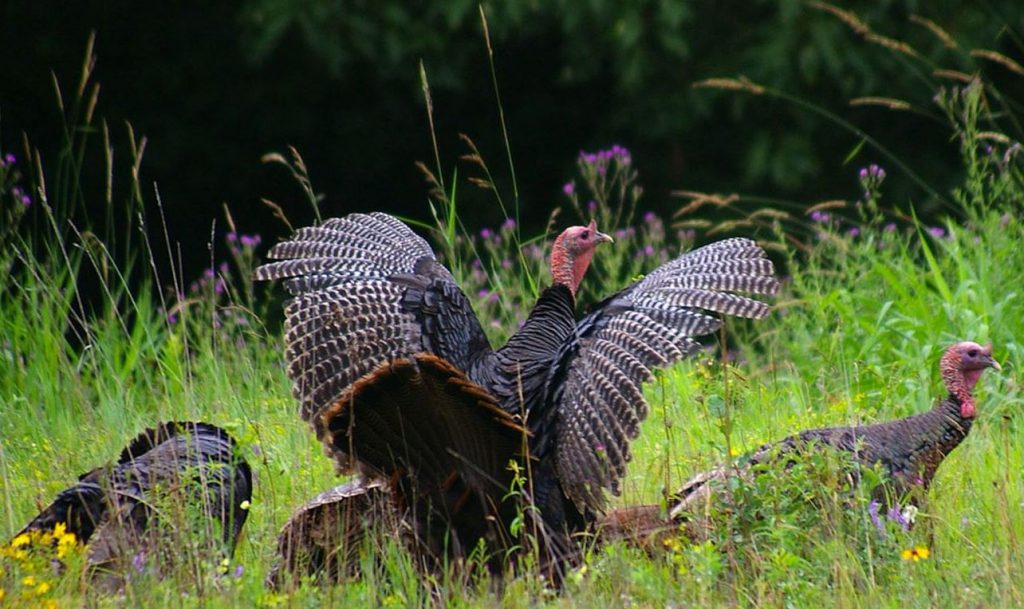The wild turkey population in Delaware is one of the greatest conservation success stories in the region. The DNREC Division of Fish and Wildlife has reintroduced wild turkeys, once lost to Delaware. It now manages an ongoing conservation program and annual turkey hunting season.
The wild turkey (Meleagris gallopavo) is a large, plump bird. It has a wide, rounded tail, long legs, and a long slim neck with a small head. Their coloration is dark, with body feathers that are generally blackish and dark with a coppery sheen.
Wild turkeys can be seen year-round in Delaware. They are most often observed during their spring mating season when male birds are competing for mates. Male birds are “toms” if an adult, and “jakes” if a first-year bird. Females are “hens.”
Turkeys are known for having a “beard,” a grouping of specialized feathers that protrudes from the breast of the bird. This is typical on males, though females can also have a beard. Delaware’s wild turkey flock has an unusually high proportion of hens with beards due to the genetics of the birds used to stock the population.
Wild turkeys are related to the domestic turkey (Meleagris gallopavo domesticus), which was originally derived from a southern Mexican subspecies of wild turkey.

Delaware’s wild turkey population has fluctuated over time. They were once common throughout the land that would become the First State. The flock was estimated to have as many as 10,000 birds before European settlement. The original human residents, particularly the members of the Lenape tribe, harvested wild turkeys for food and wove garments out of its feathers.
Early European settlers noted the abundance of wild turkeys in the 17th century. The birds remained a common part of wildlife observed in Delaware over the next two centuries.
Wild turkeys became extinct in Delaware during the late 1800s, likely due to habitat loss and overharvest through hunting. It wasn’t only the case in Delaware; throughout the eastern states, remnant populations were few and far between. The small population size and large distances limited natural expansion and reestablishment.

Early restoration efforts in the 1960s at Bombay Hook National Wildlife Refuge using farmed-raised birds had very little success.
From 1984 and through the early 2000s, the Division of Fish and Wildlife released wild turkeys into the state to reestablish a turkey population.
Using funding from hunting license sales, and with support from the National Wild Turkey Federation, state biologists released 34 wild-trapped turkeys into Kent and Sussex Counties in 1984. The birds had been trapped in Pennsylvania, New Jersey and Vermont.
Re-introductions continued and, once the population had established a foothold in Delaware, a hunting season was started in 1991.
Today, the Division estimates Delaware has a healthy statewide population of more than 6,000 birds. State biologists work with volunteer observers to gather information on turkey distribution and annual reproductive success.
The long-waited first turkey hunting season, in 1991, allowed hunting on both private and public lands. A lottery system helped manage the number of hunters on public lands to prevent overharvest.
Hunters harvested 93 birds during Delaware’s first turkey season in more than a century. Well over 600 wild turkeys are now harvested each year, with a record 785 harvested in 2023.
The current estimated of 6,000 wild turkeys in Delaware exceeds population goals set in the 1980s. It provides a sizable and sustainable population to the joy of turkey hunters and other nature lovers. The thrill of turkey hunting is now instilled as an annual spring pastime.
Related Topics: dfw, fish and wildlife, hunting, outdoors and recreation, turkey, turkey hunting, wild turkey, wildlife